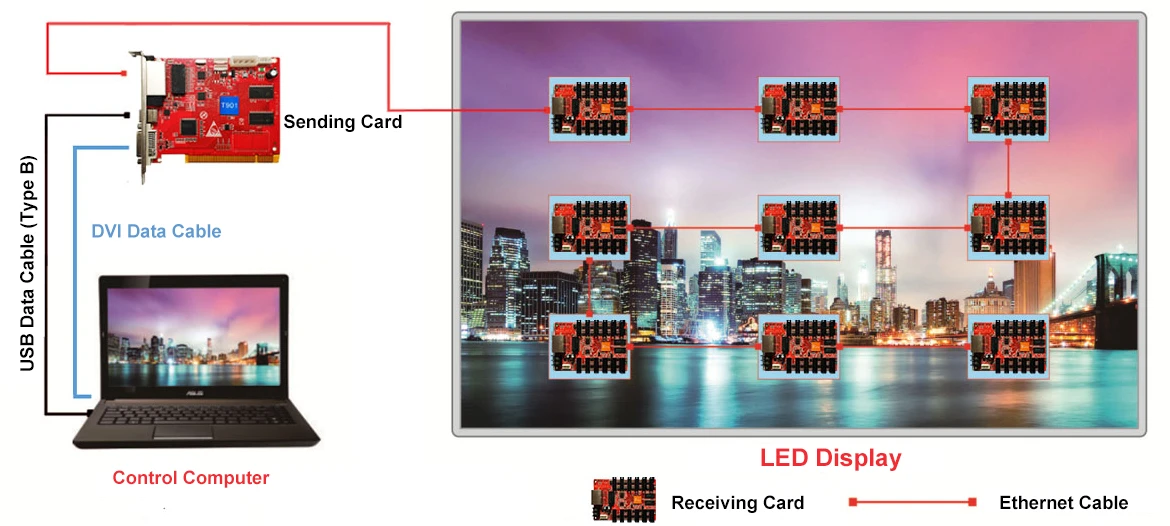
In today’s fast-paced event and entertainment industry, the ability to remotely control stage LED displays is no longer a luxury—it's a necessity. Whether you're managing a live concert, theater production, or corporate event, mastering remote LED display management ensures seamless visuals, real-time adjustments, and professional-grade reliability.
This guide walks you through everything you need to know to effectively set up, manage, and optimize your LED displays using advanced remote control systems.
Remote control transforms how LED displays are used in live events:
Real-Time Adjustments: Make instant changes to content, brightness, and layout without interrupting the show.
Centralized Management: Control multiple screens from a single interface, even across distributed venues.
Troubleshooting Without Touch: Diagnose issues and correct errors remotely, saving time and minimizing disruptions.
Scalability: Easily expand your setup for larger productions with modular control options.
Without effective remote capabilities, managing complex LED installations becomes time-consuming and error-prone.
Modern LED control solutions offer powerful tools that go far beyond basic on/off commands. Here are the key features every event planner should look for:
Using systems like the Unilumin UTV series, operators can push updates to multiple zones simultaneously via cloud platforms. This includes:
Firmware upgrades across entire LED arrays
Automatic resolution scaling for mixed-screen setups
Secure transmission with military-grade encryption
Advanced systems such as USPORT MA II allow continuous tracking of:
Temperature levels to prevent overheating
Pixel status for early fault detection
Power usage data to optimize energy consumption
These insights help maintain performance stability during long events or tours.
Sophisticated light sensors (e.g., found in the UMicro series) enable:
Automatic brightness adaptation based on ambient lighting
Scene-specific presets for different parts of a performance
Smooth transitions between lighting conditions to enhance visual flow
Ensure stable connectivity with these best practices:
Use Wi-Fi 6 or 5G backup for redundancy
Create dedicated VLANs for separating control traffic
Prioritize video packets with QoS settings
Deploy enterprise-grade routers with dual-band support
Before the show:
Assign user roles and permissions for multi-operator environments
Program keyboard macros for frequently used adjustments
Set up emergency override protocols in case of system failure
Save scene snapshots for quick recall during transitions
Protect your LED systems from unauthorized access:
Enable two-factor authentication
Use AES-256 encryption for all communications
Set automatic IP blacklisting for intrusion attempts
Security should never be an afterthought—especially when broadcasting sensitive brand content.
Once the event begins, follow these tips to keep things running smoothly:
Maintain a latency of under 50ms for real-time synchronization
Use geofencing to restrict control access to authorized devices only
Monitor diagnostics constantly and respond proactively to alerts
Have at least one backup controller station ready for emergencies
These steps ensure both creative flexibility and operational safety.
As technology evolves, so do remote LED control capabilities. Stay ahead with these upcoming innovations:
AI-powered predictive maintenance to flag faulty panels before they fail
Blockchain-based content verification for secure advertising
Holographic integration with extended reality (XR) compatible displays
5G-optimized low-latency protocols for ultra-responsive control
Adopting these technologies early can give your productions a cutting-edge competitive advantage.
A recent global music tour implemented the following remote control setup:
Modular USlim II panels for easy reconfiguration between venues
Unatural CMS platform for centralized operation of all displays
Automated power load balancing across 18 mobile generators
Real-time multilingual translation displays for international audiences
Thanks to a well-executed remote control strategy, the team reduced setup time by 40% and eliminated technical downtime between shows.
Hot Recommendations
Hot Products
Get a Free Quote Instantly!
Talk to Our Sales Team Now.
If you are interested in our products, please contact us promptly
Reach out to our sales team to explore customized solutions that perfectly meet your business needs and address any questions you may have.
Email Address:info@reissopto.comFactory Address:Building 6, Huike Flat Panel Display Industrial Park, No. 1, Gongye 2nd Road, Shiyan Shilong Community, Bao'an District, Shenzhen city , China
whatsapp:+8615217757270